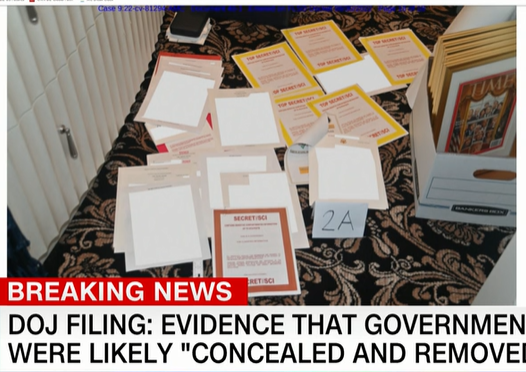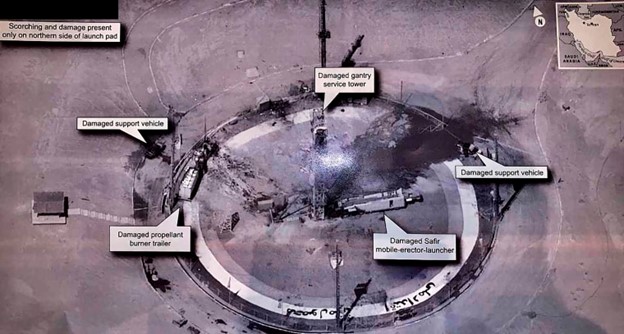
BREAKING UPDATE
The lead image to this story has been changed to reflect the photograph in “Attachment F” (taken from a CNN broadcast) to UNITED STATES’ RESPONSE TO MOTION FOR JUDICIAL OVERSIGHT AND ADDITIONAL RELIEF, Just filed by DOJ.
On August 8, the FBI found at Mar-a-Lago:
Evidence, thirteen boxes or containers contained documents with classification markings,
And in all, over one hundred unique documents with classification markings—that is, more than twice the amount produced on June 3, 2022, in response to the grand jury subpoena—were seized. Certain of the documents had colored cover sheets indicating their classification status.
Attachment F (redacted FBI photograph of certain documents and classified cover sheets recovered from a container in the “45 office”). The classification levels ranged from CONFIDENTIAL to TOP SECRET information, and certain documents included additional sensitive compartments that signify very limited distribution. In some instances, even the FBI counterintelligence personnel and DOJ attorneys conducting the review required additional clearances before they were permitted to review certain documents
No additional comment is necessary
Original Post:
One of the myriad of feeble excuses and made-up legal theories thrown around to defend Trump’s indefensible, possibly criminal acts of absconding with more than one hundred highly classified, national security documents – some additionally assigned compartments/dissemination controls of HCS (“HUMINT – Human Intelligence – Control System”), is that Trump, somehow, had “declassified” them before making off with them to his club in Mar-a-Lago.
If, for a fleeting moment, we assume that Trump may have had such questionable authority, the following critical questions are still left unanswered:
• On what basis did he declassify such documents, including those which, by their very nature, could put our most clandestine sources and most sophisticated methods at risk.
• Did he follow any procedures at all?
• Did he leave a record of such declassifications?
• Did he order the markings on the documents to be properly changed?
• Whom did he consult? Did he discuss such declassification with the originating agency? With anyone at the Intelligence community?
• Did he advise relevant communities and departments that their most closely held secrets suddenly had been declassified by the wave of a wand? Charlie Savage at the New York Times observes:
If there is no directive memorializing a decision to declassify information and conveying it to the rest of the government, the action would essentially have no consequence, as departments and agencies would continue to consider that information classified and so would continue to restrict access to documents containing it.
Setting all this aside, even assuming that Trump had magically deemed declassified the truckload of documents he carted off to Mar-a-Lago, the practical truth is that those documents still contain the nation’s most sensitive secrets.
The sad moral truth is that — “Trump-declassified or not” — in the case of HUMINT, his reprehensible, reckless actions violate the sacrosanct, time-honored principle a nation has to protect its clandestine intelligence sources, to not put those human beings at mortal risk.
Trump’s imaginary wand wave did not remove from the documents HUMINT information whose compromise could expose and possibly sentence to death men and women who risk their lives to keep us safe.
Men and women “whose identities are among the most closely protected information inside American intelligence and law enforcement agencies. Losing even one of them can set back American foreign intelligence operations for years.”
A directive from the Office of the Director of National Intelligence notes the Human Intelligence Control System (HCS) designation is “used to protect exceptionally fragile and unique” HUMINT operations and methods “that are not intended for dissemination outside of the originating agency.”
Dr. Ursula M. Wilder, a clinical psychologist who has served at the CIA for 25 years, tells us the fate that befell one of those sources who was captured. He was “killed in the village square in front of friends and relatives by terrorists using the drawn-out methods worthy of medieval torturers,” she writes.
Wilder adds, these sources “perform their clandestine term of service among the worst of humanity in order to protect what is best…They play a direct role in saving anonymous lives—those who will never know they were saved, let alone who saved them. This is a singular form of heroism, that is ongoing on our behalf, in the shadows, all over the world.”
We have not even addressed the possible compromise of the second part of “sources and methods.”
For that, one just needs to look at one perfect example of Trump’s disdainful, irresponsible treatment of such information while still President.
In 2019, Trump tweeted — against the advice of his national security experts — a highly classified image taken by one of America’s premier secret spy satellites of an Iranian missile launch site (below), giving “U.S. adversaries keen insights into the U.S. capabilities to spy from above.”

While many Republicans are shrugging this national security disaster as just another “Trump will be Trump” episode (but also weighing the rising cost of their “investment in Trump”), our national security agencies now must start the grim task of assessing the potential risk to our security caused by a former president’s incompetence and contempt for security.
Regardless of whether Trump is indicted, Americans must decide whether they would ever again entrust the nation’s secrets to a man who would henceforth not even qualify for a “Confidential” security clearance.
















